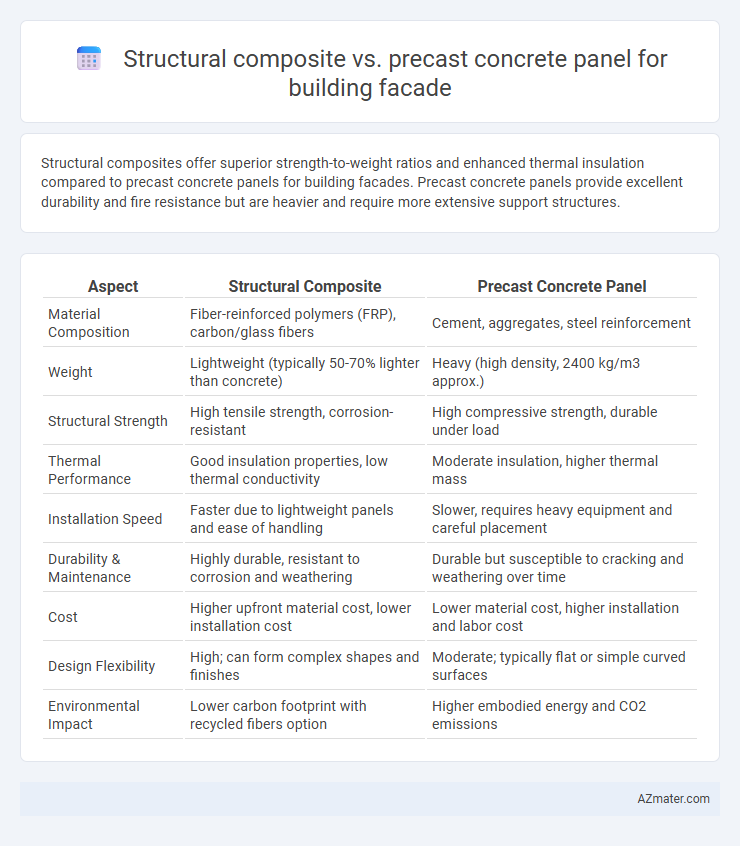Structural composites offer superior strength-to-weight ratios and enhanced thermal insulation compared to precast concrete panels for building facades. Precast concrete panels provide excellent durability and fire resistance but are heavier and require more extensive support structures.
Table of Comparison
| Aspect | Structural Composite | Precast Concrete Panel |
|---|---|---|
| Material Composition | Fiber-reinforced polymers (FRP), carbon/glass fibers | Cement, aggregates, steel reinforcement |
| Weight | Lightweight (typically 50-70% lighter than concrete) | Heavy (high density, 2400 kg/m3 approx.) |
| Structural Strength | High tensile strength, corrosion-resistant | High compressive strength, durable under load |
| Thermal Performance | Good insulation properties, low thermal conductivity | Moderate insulation, higher thermal mass |
| Installation Speed | Faster due to lightweight panels and ease of handling | Slower, requires heavy equipment and careful placement |
| Durability & Maintenance | Highly durable, resistant to corrosion and weathering | Durable but susceptible to cracking and weathering over time |
| Cost | Higher upfront material cost, lower installation cost | Lower material cost, higher installation and labor cost |
| Design Flexibility | High; can form complex shapes and finishes | Moderate; typically flat or simple curved surfaces |
| Environmental Impact | Lower carbon footprint with recycled fibers option | Higher embodied energy and CO2 emissions |
Introduction to Building Facade Materials
Structural composites offer enhanced flexibility and lightweight properties for building facades, providing improved thermal insulation and design versatility. Precast concrete panels deliver high durability and reduced construction time, with excellent fire resistance and soundproofing capabilities. Selecting between these materials depends on project requirements such as load-bearing capacity, aesthetic preferences, and environmental performance.
Overview of Structural Composite Panels
Structural composite panels consist of layered materials bonded to deliver high strength-to-weight ratios and superior thermal insulation, making them ideal for modern building facades. These panels integrate materials such as fiberglass, foam cores, and metal skins, providing excellent durability, weather resistance, and design flexibility compared to traditional precast concrete panels. Their lightweight nature reduces structural load and simplifies installation, offering cost-effective solutions for energy-efficient and aesthetically versatile facade systems.
Overview of Precast Concrete Panels
Precast concrete panels offer superior durability, thermal insulation, and fire resistance compared to structural composites, making them ideal for building facades in diverse climates. These panels are manufactured under controlled factory conditions, ensuring high quality, dimensional accuracy, and faster onsite installation. Their ability to incorporate complex architectural designs and structural reinforcements provides versatility and strength while reducing construction time and labor costs.
Material Composition and Manufacturing Process
Structural composite facades typically consist of layered materials such as fiber-reinforced polymers combined with core materials like foam or honeycomb, offering high strength-to-weight ratios and enhanced durability. Precast concrete panels are made from a mixture of cement, aggregates, water, and chemical admixtures poured into molds and cured under controlled conditions, providing robust thermal mass and fire resistance. The manufacturing process of structural composites involves layering and curing under heat and pressure, while precast concrete panels undergo casting, vibration, and steam curing to achieve structural integrity.
Structural Performance and Load-Bearing Capacity
Structural composite panels offer superior tensile strength and flexibility, allowing for enhanced seismic resistance and load distribution in building facades. Precast concrete panels excel in compressive strength and durability, providing excellent load-bearing capacity under static and dynamic loads with minimal deflection. Both systems can be engineered for optimized structural performance, but composites typically reduce overall weight while precast concrete ensures robust fire resistance and long-term stability.
Thermal Insulation and Energy Efficiency
Structural composite panels provide superior thermal insulation due to their multi-layer construction incorporating high-performance insulating materials, significantly reducing heat transfer and enhancing energy efficiency in building facades. Precast concrete panels, while durable and strong, often require additional insulation layers to meet modern energy efficiency standards, as their thermal mass alone can lead to heat retention. The enhanced insulation properties of structural composites contribute to lower HVAC energy consumption, making them a more energy-efficient option for facade systems in both residential and commercial buildings.
Aesthetic Flexibility and Design Options
Structural composites offer superior aesthetic flexibility for building facades, enabling intricate shapes, textures, and finishes that are difficult to achieve with precast concrete panels. Their lightweight nature allows for innovative design options, including complex curves and varying thicknesses, enhancing architectural expression. Precast concrete panels, while robust and durable, often have limitations in customization and tend to favor more rigid, planar designs with fewer textural variations.
Installation Speed and On-site Construction
Structural composite panels significantly reduce installation time compared to precast concrete panels due to their lighter weight and modular design, which facilitates faster handling and assembly on-site. Precast concrete panels require heavy machinery for placement and longer curing times, often extending the overall construction schedule. Faster on-site installation of structural composites minimizes labor costs and decreases project timelines, enhancing construction efficiency for building facades.
Longevity, Maintenance, and Durability
Structural composites offer superior resistance to environmental degradation, providing enhanced longevity and minimal maintenance compared to precast concrete panels, which are prone to cracking and weathering over time. Precast concrete panels require periodic sealing and repair to maintain durability, whereas composites resist corrosion, rot, and UV damage, extending the facade's lifespan significantly. The advanced material properties of structural composites result in lower maintenance costs and greater structural integrity under diverse climatic conditions.
Cost Analysis and Sustainability Considerations
Structural composite panels offer a cost-effective facade solution through reduced labor and faster installation compared to precast concrete panels, which require extensive formwork and curing time, increasing project timelines and expenses. Sustainability considerations favor structural composites due to their lightweight nature, allowing for lower transportation emissions and reduced structural load, while precast concrete panels possess high thermal mass and durability, contributing to energy efficiency and long-term material resilience. Life cycle cost analysis reveals that despite higher initial costs, precast concrete panels may provide savings over time through minimal maintenance and enhanced facade longevity.

Infographic: Structural composite vs Precast concrete panel for Building facade
 azmater.com
azmater.com